Before I get started, I just wanted to give a shout-out to everyone involved with STS-134 – Endeavor’s final mission. I met the crew while we were filming at Johnson Space Center, and they couldn’t be a friendlier bunch. Among other things, they delivered the Alpha Magnetic Spectrometer (AMS) experiment to the ISS. Just like in the origin story of the FANTASIC FOUR, there really are cosmic rays in space, and the AMS will investigate them to improve our understanding of antimatter and possibly probe the nature of the elusive Dark Matter that makes up most of the mass in the universe. This is serious science – the Principal Investigator is Nobel Laureate Samuel Ting. The shuttle crew members are risking their lives to better our understanding of the universe, and I think that is a pretty incredible thing. And Mike Massimino isn’t just a co-host on our show, he’s still a working astronaut. For this mission he’s been working as CAPCOM (Capsule Communicator). That’s the person at mission control (generally an astronaut) that the astronauts in space are talking to. So good job Mike, Shuttle crew, and everyone involved at NASA, on a successful mission.
EPISODE 305: BIGGEST COSMIC BLASTS
One thing I’ve learned from my experience helping to create this season of KNOWN UNIVERSE is that TV people think very differently than scientists. I don’t mean that in a bad way – most scientists I know are horrible at capturing people’s attention. We tend to give hour-long talks to each other about our research, and let me tell you, as an audience member, sometimes a mind-numbingly boring talk can seem like the longest hour of your life. Many scientists get right into the nitty-gritty details and forget to give you the big picture first. But most importantly, they often lack any narrative or sense of drama. TV can suffer from the opposite problem – people in TV generally know how to do drama and narrative very well, but sometimes they want to leave out the details. Details can complicate the story, but in a science show, the details are often the most critical elements.
Every science show must strike a balance between narrative and details. Sometimes we get it right, and other times we stumble. Since I want this series of articles going behind the scenes on the show to go a bit deeper than just cheerleading, I thought I’d use this episode as fodder to explore why we sometimes get things right, and why sometimes we could have done better.
MIKE VS. LAVA, ANDY VS. LAVA
If you ever drop your keys into a river of molten lava, let 'em go, because, man, they're gone. – Jack Handey
By now you might have noticed a pattern on the show. Mike gets to look like a badass, and I get totally screwed with! This episode does not disappoint in that department.
A major focus of this episode is volcanoes, both here on Earth and elsewhere in the solar system. What a better place to start than Hawaii? Hawaii was created by volcanoes, and is still in the process of growing as lava is flowing into the ocean and cooling into rock. Mike (lucky dog) got to fly to Hawaii, get on a boat, and go to the very spot where this is happening.
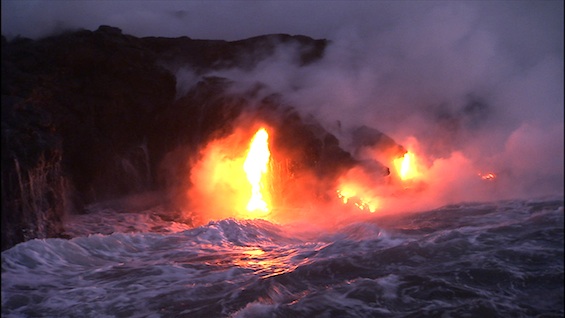
It is a pretty impressive spectacle. Afterwards, Mike talked to a vulcanologist, and actually got to walk up to some lava and play with some using a hammer! Molten rocks from the mantle of the Earth – that is awesome stuff, and it is impressive to see it and manipulate it on the surface. It can even create land where there used to be ocean! Here’s Mike as king of mountain made out of what used to be lava.
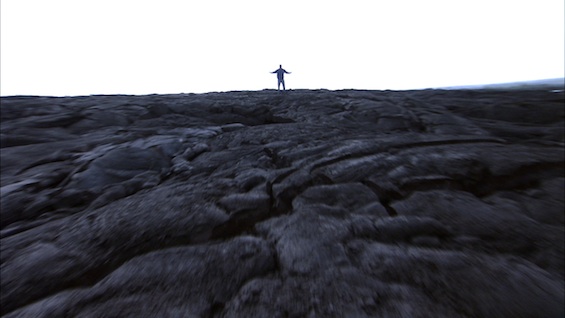
But as lava flows go, the stuff in Hawaii is fairly tame stuff – it moves slowly enough that a person can outrun it. That isn’t true of all lava flows. To illustrate the difference, we had our special effects crew build a giant sluice and pour simulated lava down it. Meanwhile I’d be running underneath it trying to beat the flow.
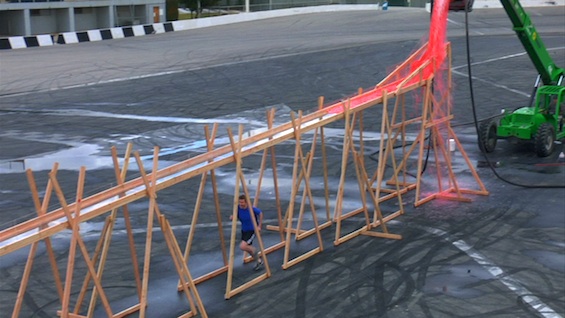
Now, I’ve always had a thing about how in every movie trailer with Tom Cruise, they have a shot of him running. He has a strange, ramrod-straight running style, and I find it kind of funny, or at least I used to. I joked about this to one of the cameramen on KNOWN UNIVERSE, and he said, “What are you talking about, Tom Cruise is one of the best runners in the business!” For some reason, I’m the go-to guy when they need running on the show: on a track, on the moon, on cornstarch, below lava… Having seen myself run on TV a few times (even in slow motion on the commercials for this episode), let’s just say it is very hard to look cool while running! I concede, Tom Cruise is an excellent runner.
But there’s more to this than what you’ll see on TV. For one thing, I was sick, and pumped up on cold meds so I could film the segment. But making matters worse, it was a cold day in LA, and all I could wear was shorts and a t-shirt.
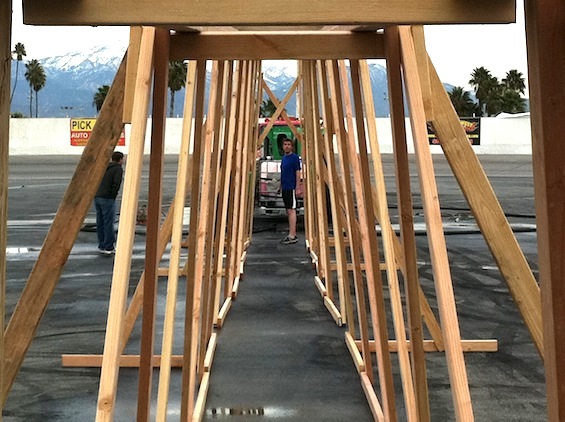
Notice the snow on the mountain and the fact that Scott Goldie, the director giving me direction has on a jacket and pants and still looks cold. When models complain about having to do photo shoots in a bikini in the dead of winter, I used to say, “boo hoo.” Now I have some sympathy! Making matters worse, the simulated lava was just very, very cold water with stuff in it, and for some takes I had to get drenched.
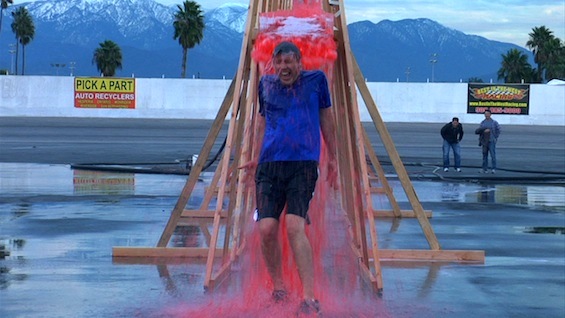
For the second time on the show, I take a bath in nasty stuff in the name of science, while in the background my tormentors, segment director Scott Goldie and show runner Bob Ziel look on.
In fact, they had two identical sets of clothes for me to wear so that I could get soaked, change clothes, and we could do another take. Unfortunately, we didn’t get the shot in two takes! It takes time to set up for a new shot, and I had to keep my wet clothes on for the next shot. In desperation, they threw me in the back of a moving truck just to get me out of the wind, where I sat shivering while they set up. When they were ready, a PA lifted up the door and I ran out to do another shot.
It was a real pain to film, but the finished product it worth it. These two segments – the one with Mike and the real lava and me outrunning the fake stuff are examples of us getting it right. There’s real science there, and putting the hosts in the middle of it really leaves an impression.
ALIEN VOLCANO DETECTIVES
Volcanoes are cool, but they are also important for the development of an atmosphere, and possibly oceans, on a planet. The early Earth’s atmosphere came about from volcanic outgassing. It wasn’t oxygen-rich – that only happened as the result of life. Even the ocean was formed at least partially by volcanic outgassing, since it was too hot on the molten early Earth to have water.
Did you know that in principle we can actually detect whether a planet around a distant star has volcanoes? You do this by taking a spectrum -- splitting the light from the star up into a rainbow and then measuring the absorption of light from different elements. You compare the spectrum when the planet is in front of the star, when its atmosphere is absorbing some of the starlight, to a spectrum when it is behind the star. We have not detected volcanoes yet, but astronomers have been able to detect elements in the atmospheres of distant planets. We can’t even see the planet directly, and yet with clever tricks we can find out whether there are volcanoes. That’s pretty remarkable, even to a jaded astronomer like me.
To demonstrate this, we built cylinders and filled them full of different gasses. Then we had Steve “Jake” Jacobs put them in front of a light source, while Sigrid Close measured their spectra with a spectrograph.
Sigrid and Jake did a great job (Sigrid had to fill in for me at the last minute as it turns out). But in the end, in the tug-o-war between simplicity and detail, most of the details about how a spectrograph works were edited out or glossed over this segment. The segment works fine, and it is always a tough balancing act, but I think it is a case where more detail actually could have made the story more interesting.
SPACE GEYSERS
We’re used to volcanoes bursting with hot lava, but did you know there are cold cryovolcanoes in the solar system too? For example, on Saturn’s moon Enceladus, jets of water break out of the surface and shoot up so high they can escape the moon’s gravity. Particles from these jets are thought to give rise to Saturn’s F ring.
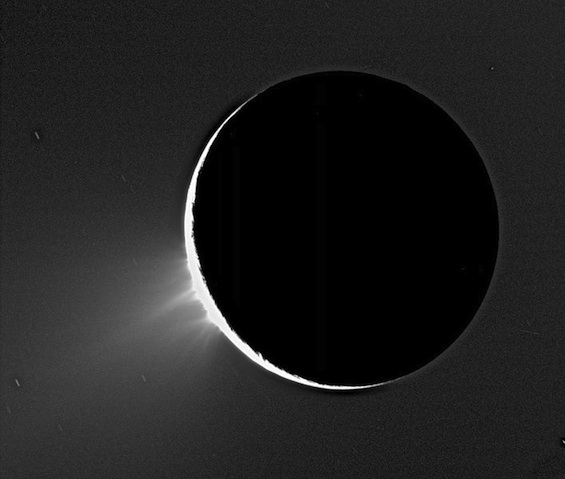
Image of Enceladus taken by Cassini showing geysers of water erupting from the surface.
But how can this happen on an ice world? The key is pressure. To demonstrate this, Jake and Mike poured wax onto an aquarium filled with water to create a solid surface. Then below the surface they put a bottle filled with dry ice. When it sublimated, the expanding gas ruptured the bottle, and BOOM!
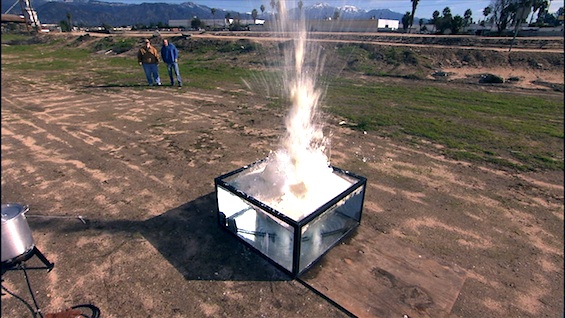
Here’s the video:
This is another example of everything working together. The demo is a direct analogy of what is happening on a moon. Plus, it is fun and dramatic. I love it when cool explosions illuminate some scientific principle.
WE WILL ROCK THEE
Next up on our tour through cosmic blasts – solar flares and plasma. The sun has many giant eruptions of plasma – these can damage satellites, and even disrupt electrical grids on Earth.
Plasma – is just ionized gas. That’s what you get in lightning. You know we don’t do anything small-scale on this show. How are we going to do lightning? How about a guy in a suit of chain mail getting hit by lightning? Not exciting enough? How about while playing a guitar!
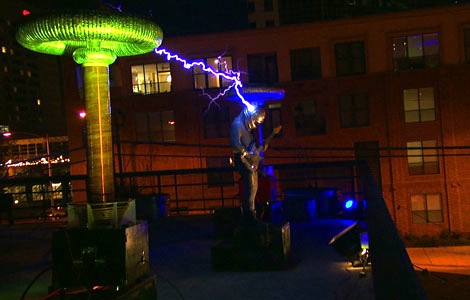
Yes! We show this band, Arc Attack, who play instruments in chain mail suits while getting hit by electricity from giant Tesla coils. Chain mail! Check it:
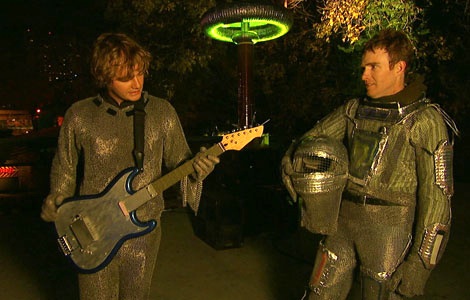
Now why would you wear a conducting suit and hang around near electricity, much less taunt it with awesome jams? You can do it because the electric field inside a conductor is zero. The suit acts like a Faraday cage. They also play music with Tesla coils. Man I wish Beavis and Butthead were still on the air so they could comment on these guys.
As awesome as these guys are (and they are super-awesome), this is an example where entertainment value trumps scientific content. To me the show works best when we wow you and then sneak some knowledge in there. We did but this is a long segment about music, and a big aside, just to barely mention flares and lighning.
BLACK HOLE ERUPTIONS
The biggest space eruptions of them all come from black holes. But how can that be if they have such immense gravity? That’s because material is orbiting a black hole in a disk at such high speeds that friction heats the material until it explodes out perpendicular to the disk at a speed higher than the escape velocity of the black hole. The escape velocity only exceeds the speed of light inside the event horizon – this is outside of that point of no return. The erupting material can then get directed by magnetic fields into huge jets. There is a black hole at the center of every galaxy, and those that are feeding are sending out these huge death rays.
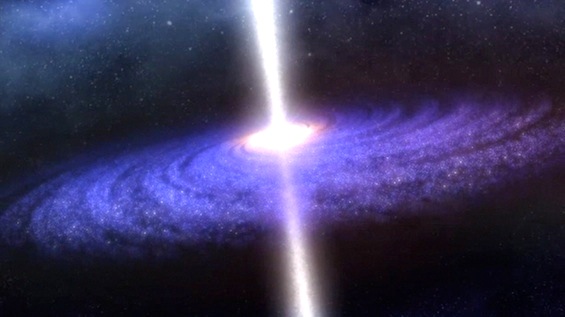
How do we make a demo to show this? We brainstormed all kinds of ideas. I think they even built a model to test one of my suggestions, but it just didn’t work. In the end, the solution was to get an old satellite dish, fill it with swirling explosive gasses, and have it competing with suction happening through holes in the dish. If the gas explodes with enough force, it could escape off the surface of the dish. Jake and David Kaplan made it happen.
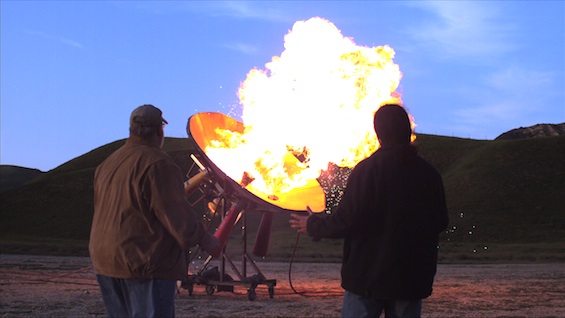
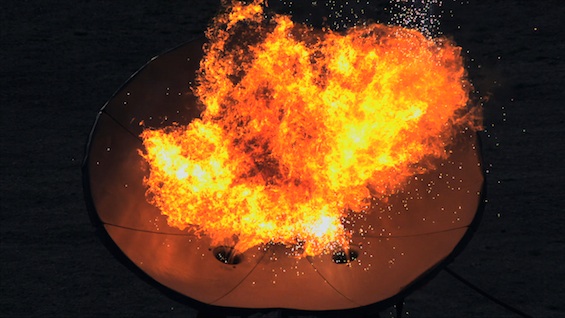
That sure does look spectacular. Still, it is probably my least favorite demo on the show. Why? Because it is all show and does little to advance your understanding of what is going on. In fact, it is in danger of doing the opposite – reinforcing people’s misconceptions about black holes. Most people think black holes have some kind of super-suction, and anything nearby will get sucked in. But in reality, things can orbit a black hole with no problem. You could replace the Sun with a black hole of the same mass, and the Earth would orbit just fine. The thing that makes black holes special, and crazy, is that you can get very close to them because they are so condensed. If you were very close to a black hole, to stay in orbit you’d have to be moving very quickly. Gas in orbit going this fast gets heated by friction until it glows in x-rays. And when it explodes it is fighting gravity, not suction. The demo doesn’t really tell you anything about black holes.
I actually never saw or heard about the demo before it was filmed, but after I saw the finished version, the producers of the show worked with me to change the wording of what is said to clear up any misconceptions a viewer might get from the demo. This was easier said than done. In one case they had to take a word out of the middle of a sentence uttered by David Kaplan and replace it with another one he’d said at another time. The magic of TV!
All in all, the episode is entertaining, and scientifically accurate. Where it works best is when we have the hosts in a segment in some kind of jeopardy or funny situation, and out of that comes a better understanding of the science we want to communicate. When it doesn’t work as well, in my opinion, is when the scientific details take a backseat to the entertainment value.
Having said that, the show is about a million times better than having to sit through almost any hour lecture on any one of the science topics we cover. If we can capture your attention and keep you interested, you can always read up more on the concepts later. But if we never get your attention in the first place, it doesn’t matter how many details we pack into the show. TV is one place where you want to err on the side of awesomeness.
Check it out – this episode Thursday, June 2 at 9 pm Eastern on National Geographic.
-Andy Howell aka Copernicus
